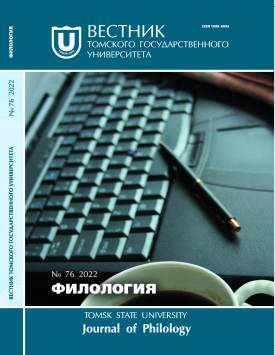Intersemiotic adaptation of euphemisms: Linguistic and multimodal approaches
The article discusses the intersemiotic adaptation of textual fragments containing euphemisms from the literary drama text to the film. The samples are 37 units (24 original euphemisms and their 37 cinematographic verbal representations) from the three plays by Oscar Wilde (The Importance of Being Earnest, An Ideal Husband, Lady Windermere’s Fan) and 32 video episodes from 6 film adaptations of these plays. The methods of statistical and linguistic analyses employed while investigating euphemisms showed that about one half of all euphemisms are omitted, which is due to the change of the sociocultural context (for example, the purple of commerce) and the need to fit the time frame allocated for a particular film. The majority of euphemisms are translated without any transformation; only five have been transformed. The reasons for this are two-fold. On the one hand, the producers pursue the simplification of the content of the original play, for instance, “Mrs.Cheveley’s past is merely a slightly decolette one” [An Ideal Husband] was adapted to “Mrs.Cheveley’s past is merely a little too revealing” [1947]. On the other hand, the producers chose to retain and emphasise the individual peculiarities of Wilde’s style: the euphemism “a woman of - well, more than doubtful character” [Lady Windermere’s Fan] is adapted to “a woman of rather doubtful character. So doubtful in fact that there is no doubt whatsoever about it.” [1949] In the earlier adaptation of the play, the producer (Otto Preminger) employed polyptoton to create a pun, with Wilde being a master of wordplay. The multimodal analysis of the samples demonstrated the following results: (1) the majority of euphemisms are adapted with the help of the communicative modes of intonation, facial expression and pauses (e.g. walk in the mire), which is fairly predictable since concealing the unpleasant facts of reality - the main function of euphemism - gets rendered primarily via spoken language and facial expressions; however, in certain cases the cinematographic codes of visual frame and composition, as well as the mode of proxemics, enhance the meaning of the euphemism in question (e.g. far from indifferent to you); (2) there have been revealed three types of relation between the verbal mode, on the one hand, and the nonverbal modes, on the other: coordination, complementarity and contradiction. The relation of coordination, or equivalence, predominates (31 units out of 37), which evidences the almost unequivocal interpretation of the same euphemism by two different producers (e.g. Wagnerian manner, bed ofpain, loss in the family). The authors declare no conflicts of interests.
Keywords
intersemiotic adaptation, resemiotisation, mode, euphemism, film adaptation, film stylistics, multimodal analysisAuthors
| Name | Organization | |
| Koroteeva Valentina V. | Novosibirsk State University | valentina.shilova77@gmail.com |
| Zheleznikova Natalia V. | Tomsk State University | getsquare@gmail.com |
References

Intersemiotic adaptation of euphemisms: Linguistic and multimodal approaches | Vestnik Tomskogo gosudarstvennogo universiteta. Filologiya – Tomsk State University Journal of Philology. 2022. № 76. DOI: 10.17223/19986645/76/4
